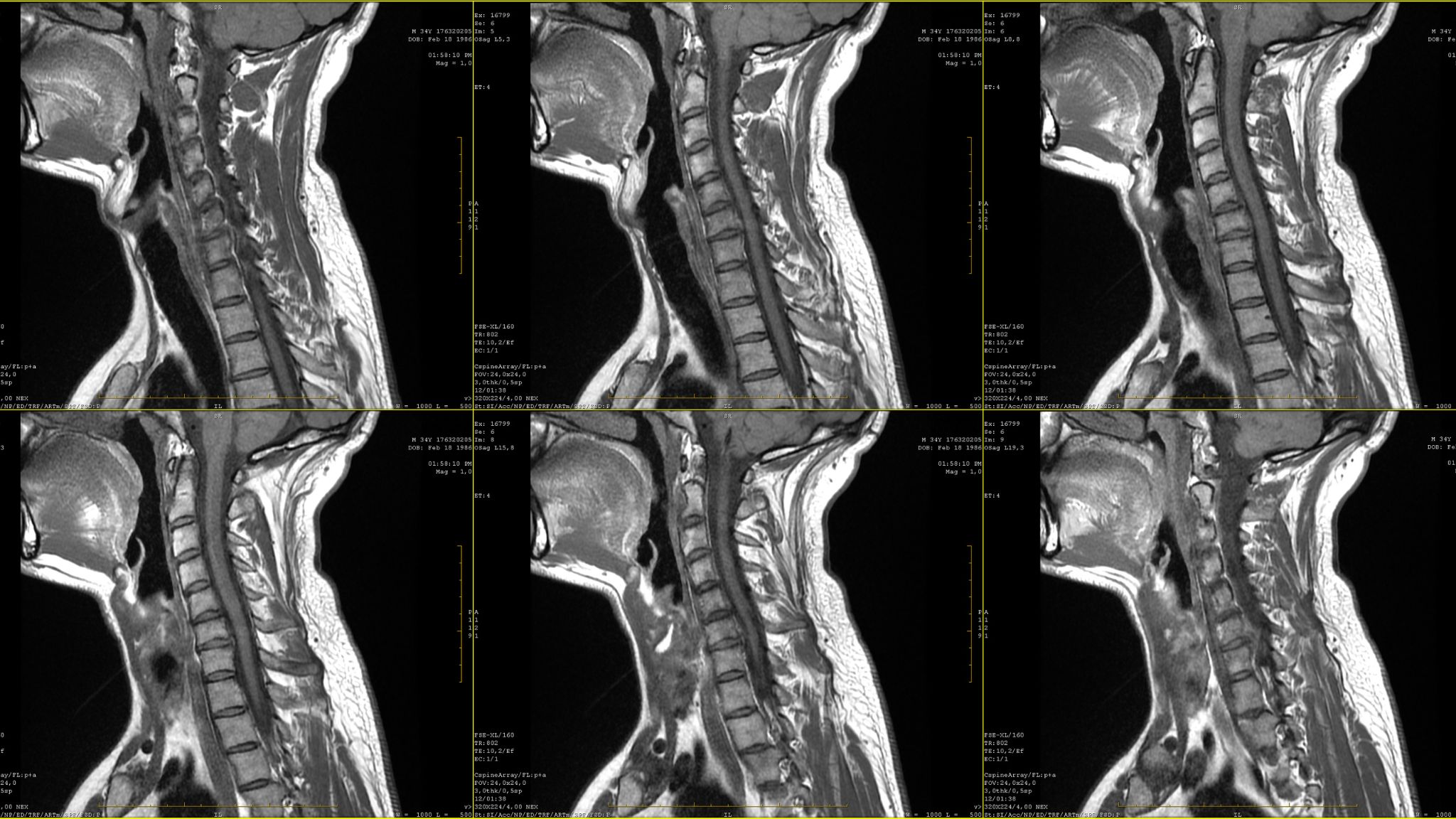Cervical radiculopathy, frequently called a “pinched nerve,” is a common ailment that can cause discomfort and disrupt daily life. However, with proper self-care measures, it’s possible to manage and alleviate its symptoms.
This post aims to provide an overview of self-care strategies for cervical radiculopathy. It’s essential to understand that while at-home practices play a critical part in managing this condition, the assistance of a medical professional, such as a chiropractor or physical therapist, is a great plus.
What is Cervical Radiculopathy?
Cervical radiculopathy is a condition that results from nerve compression in the neck (a.k.a. cervical spine). This compression, in turn, leads to symptoms, like pain or weakness, radiating (hence the term “radiculopathy) into other parts of the body like the arm or hand. When this happens, it can significantly disrupt your routine and life.
- Cervical Radiculopathy Symptoms The primary symptom of cervical radiculopathy is pain that, as noted above, often spreads into the arm, neck, chest, upper back, and/or shoulders. Other symptoms include tingling or numbness in the fingers or hands and weakness in your hand or arm.
- Does cervical radiculopathy go away? Yes, cervical radiculopathy will often resolve over time, provided you implement proper self-care practices and receive some medical intervention. You are advised NOT to try to go it alone, however, as cervical radiculopathy can lead to permanent nerve damage if left untreated.
Physical therapists are experts in musculoskeletal health and can provide advice and treatments customized to the individual to help manage the condition. This can lead to a decrease in the pain and discomfort typically associated with cervical radiculopathy.
But that does not mean you can’t take an active role in your self-care. No, there are things you can do – from cervical radiculopathy exercises to stretches and more – to help you take control of your healthcare journey.
Let’s explore some of your options.
1. Stretches
- Trap Stretch: Sit on a chair with the hand on the shoulder you wish to stretch placed under your buttocks. Reach up with the opposite hand to grab your head and gently tilt it in the opposite direction. Hold for 15-30 seconds, then switch sides. Repeat three times on each side.
- Neck Extensions: Sit or stand straight, then slowly tilt your head back as far as comfortable, looking at the ceiling. Hold for 5-10 seconds, then return to the neutral position. Repeat this ten times.
- Side Tilts: In a standing or sitting position, tilt your head gently towards one shoulder until you feel a slight stretch. Hold for about 5 seconds, then repeat on the other side. Do this ten times for each side.
- Cervical Radiculopathy Yoga: Yoga can substantially relieve cervical radiculopathy symptoms due to its focus on flexibility and strength. Poses like the “Cat-Cow” and “Extended Triangle” are particularly beneficial as they improve neck mobility and posture.
2. Exercises
- Chin Tuck: Stand or sit upright, then gently draw your chin straight back while keeping your eyes forward. Hold for 5 seconds, then relax. Repeat this ten times.
- Nerve Glides, a.k.a Neural Flossing: Start by sitting upright and slowly extending the affected arm to the side, palm facing upward. Move your extended arm back a little. Next, lower your palm by bending your wrist while tilting your head toward the extended arm simultaneously. Repeat ten times on each side.
- Isometric Holds: Push your palm into your forehead and resist with your neck muscles. Hold for 5 seconds, then relax. Repeat ten times.
- Shoulder Circles: Lift your shoulders towards your ears, and then roll them back and down. Do this ten times, then reverse the direction and repeat.
- Side to Side Strengthener: Stand or sit upright, then gently turn your head to one side until your chin is over your shoulder. Hold for a few seconds, then slowly return to the center and repeat on the other side. Do this ten times for each side.
3. Ice and Heat
Both ice and heat can also be beneficial. Ice packs reduce inflammation and numb pain, especially in the acute phase of pain or after a strenuous activity. On the other hand, heat can help relax muscles and improve circulation, which can be particularly beneficial for chronic conditions.
Of course, it’s important to remember not to apply ice or heat directly on the skin. You should also limit each session to only 15-20 minutes.
4. Lifestyle Modifications
If you are suffering from cervical radiculopathy, there are several lifestyle modifications you can make to help manage your symptoms and improve your overall health:
- Maintain Good Posture: Practice good posture, especially if you spend a lot of time sitting or working at a computer. Keep your back straight and shoulders back, and ensure your computer screen is at eye level.
- Stay Hydrated: Drink plenty of water throughout the day. This can help keep your discs — the spongy structures between the bones in your spine — healthy.
- Avoid Tobacco and Alcohol: Smoking can accelerate the degeneration of discs, and excessive alcohol can lead to dehydration and make your symptoms worse.
- Weight Management: Maintaining a healthy weight can reduce pressure on the spine and alleviate symptoms.
- Rest: Ensure you get enough rest and try relaxation techniques such as deep breathing or meditation to help manage stress, which can exacerbate your symptoms.
- Ergonomic Workstation: If you work at a desk, ensure your workstation is ergonomically designed to minimize strain on your neck.
- Regular Checkups: Consult your healthcare provider to monitor your condition and adjust your treatment plan.
Remember, it’s essential to consult with a healthcare professional before starting any new exercise or diet program.
5. Mind-Body Techniques
The power of the mind is becoming increasingly recognized by modern science. Incorporating mind-body techniques such as meditation and deep breathing into your daily routine can lower stress – a factor that very often contributes to muscle tension and pain. It can also reduce the frequency and intensity of cervical radiculopathy flare-ups.
6. Medication and Diet
In addition to stretches and exercises, there are several things you can do to assist in your treatment without even leaving your house.
Medication and Diet: Over-the-counter nonsteroidal anti-inflammatory drugs (NSAIDs) like ibuprofen, for example, can help reduce inflammation and pain. Additionally, maintaining a healthy lifestyle that includes not just regular exercise, like the ones listed above, but a balanced diet as well, can support overall neck health and prevent further complications.
- Cervical Radiculopathy Diet: Consuming a diet rich in anti-inflammatory foods like fruits, vegetables, lean proteins, and whole grains is preferred because it helps manage inflammation. Staying hydrated can maintain disc health and is also suitable for muscle strength.
7. Physical Therapy
Physical therapy has multiple techniques and exercises at its disposal. Manual therapy techniques, for example, make up a key component of physical therapy. This practice involves hands-on manipulation of soft tissues. This approach can help alleviate pain and improve mobility.
Physical therapy also empowers patients with self-management strategies. This approach equips patients with the tools to continue their healing journey at home, transforming them from passive care recipients into active participants in their recovery. It’s like passing the conductor’s baton, enabling patients to lead their health symphony.
The value of physical therapy extends beyond immediate symptom relief. Addressing the root causes of cervical radiculopathy can potentially prevent future episodes, creating a ripple effect of well-being. This proactive approach is reminiscent of the adage – that prevention is better than cure, a timeless wisdom that remains relevant in modern healthcare.

The Science of Cervical Radiculopathy
The scientific community has studied cervical radiculopathy for many years. There is considerable evidence-based support for conservative therapies. These non-surgical interventions are typically the first line of treatment due to their effectiveness and lower risk profile than surgery. Some of these conservative therapies can be implemented in a self-care regime – with prudent advice and direction from a healthcare professional.
A study in Musculoskeletal Care set out to explore the prevalence of cervical radiculopathy in the adult population. In some sense, the study failed as it could not determine a consistent rate across all populations. But, of the nine populations examined, the prevalence ranged from 0.832 per 1000 person-years to as high as 5.8. This indicates that rates of cervical radiculopathy vary, and further studies are needed to determine why.
A study published in the Archives of Physical Medicine and Rehabilitation discusses the utilization of neck-specific training and prescribed exercise as effective treatment options for cervical radiculopathy. The research found that these conservative treatments can improve strength and flexibility, reduce pain, and enhance overall quality of life.
Lastly, a similar study from Physiotherapy Theory and Practice delved further into the impact of a specific exercise program on cervical radiculopathy symptoms. The study found that a structured and targeted exercise regimen significantly reduced the occurrence and intensity of headaches and dizziness caused by cervical radiculopathy. This reinforces the vital role exercise plays in managing cervical radiculopathy.
Now that we’ve touched on a few studies about cervical radiculopathy and we’ve discussed more thoroughly some of the self-care options a patient has at his or her disposal, we don’t want to part without repeating that changes in diet, exercise routines, or medications should only be made after consulting a medical professional. Don’t try to do it alone.
Additionally, we want to emphasize that if you suspect that have cervical radiculopathy but you don’t know for sure, you are strongly urged to seek out a medical professional to get properly tested. Generally, a proper diagnosis requires a chiropractor, nurse practitioner, or MD to be considered “official.”
Conclusion
To conclude, if you’re tired of the constant pain and discomfort of cervical radiculopathy disrupting your life, you’ve got a solution right here in Anchorage.
Better Health Alaska offers chiropractic care treatments that can provide immediate relief and long-term solutions to your neck pain. Our expert team is committed to helping you regain control of your health and improve your quality of life.
Don’t let cervical radiculopathy hold you back any longer. Take the first step towards lasting relief. Call Better Health Alaska today and start your journey to a pain-free life.









